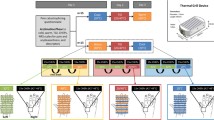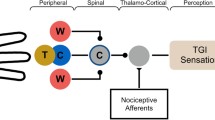Abstract.
In a previous study of the heat grill illusion, sensations of burning and stinging were sometimes reported when the skin was cooled by as little as 2°C. Informal tests subsequently indicated that these nociceptive sensations were experienced if cooling occurred when the stimulating thermode rested on the skin, but not when the thermode was cooled and then touched to the skin. In experiment 1 subjects judged the intensity of thermal (cold/warm) and nociceptive (burning/stinging) sensations when the volar surface of the forearm was cooled to 25°C (1) via a static thermode (Static condition), or (2) via a cold thermode touched to the skin (Dynamic condition). The total area of stimulation was varied from 2.6 to 10.4 cm2 to determine if the occurrence of nociceptive sensations depended upon stimulus size. Burning/stinging was rated 10.3 times stronger in the Static condition than in the Dynamic condition, and this difference did not vary significantly with stimulus size. In experiment 2, thermal and nociceptive sensations were measured during cooling to just 31°, 29° or 27°C, and data were obtained on the frequency at which different sensation qualities were experienced. Stinging was the most frequently reported nociceptive quality in the Static condition, and stinging and burning were both markedly reduced in the Dynamic condition. In experiment 3 we tested the possibility that dynamic contact might have inhibited burning and stinging not because of mechanical contact per se, but rather because dynamic contact caused higher rates of cooling. However, varying cooling rate over a tenfold range (–0.5° to –5.0°/s) had no appreciable effect on the frequency of stinging and burning. Overall, the data show that mild cooling can produce nociceptive sensations that are suppressed under conditions of dynamic mechanical contact. The latter observation suggests that cold is perceived differently during active contact with objects than during passive heat loss to the environment. Hypotheses about the physiological basis of the nociceptive sensations at mild temperatures and their possible role in the phenomena of paradoxical heat and synthetic heat are discussed.
Similar content being viewed by others
Author information
Authors and Affiliations
Additional information
Electronic Publication
Rights and permissions
About this article
Cite this article
Green, B.G., Pope, J.V. Innocuous cooling can produce nociceptive sensations that are inhibited during dynamic mechanical contact. Exp Brain Res 148, 290–299 (2003). https://doi.org/10.1007/s00221-002-1280-9
Received:
Accepted:
Issue Date:
DOI: https://doi.org/10.1007/s00221-002-1280-9




